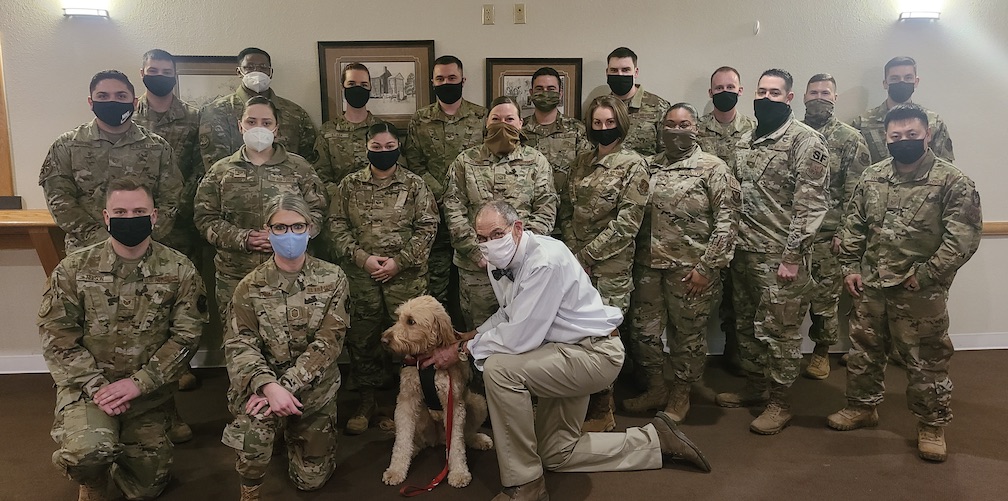Perhaps the most profound thing which I have learned over the last six months is that my brain constantly is lying to me about what will make me happy. It is telling me I need a new car, time off work, or more money. All lies! When I first started thinking about this, that my brain was sending me misinformation, it seemed to me that the perfect illustration of this idea was the optical illusion.[1] In an optical illusion things look different than they really are, and it is difficult to believe that what you see is a distortion of reality. That is because most of the time, your eyes and brain work very well together. That is how we can drive, ride a bike, read, play ping pong, and do just about everything. However, as the optical illusion illustrates, sometimes our brain doesn’t see reality exactly as it is.
An Illustration: It looks like the birds are flying out of painting.

As I have been leading the happiness conversation (teaching the science of well-being) on Wednesday evenings and teachin my First Term Airmen Class (FTAC), it seems to me that it is almost impossible to convince others that this is the case. Science has shown that our brain lies to us about a lot of things, but we often make the biggest mistakes when we believe what our brain when is telling us about money, love, the future, and our dream job. When I was in my 20s and 30s, I made a lot of good decisions about these areas of my life, but it wasn’t because I believed my brain. And it wasn’t because I was guided by science; scientists have only been doing research in these areas of life for the last twenty years. I made some good decisions because I believed the Bible. It seems to me that the Bible adds a corrective element to the signals our brain is sending to us.
However, the science of the last twenty years is still helpful for two reasons. First, it confirms what the Bible teaches, giving it credibility, and it allows me to talk about truth without sounding religious. Second, science is able to give clarity, detail, and helpful modern language to these truths.

THE REAL ELEMENTS OF A DREAM JOB
As a life coach and high school teacher I often talk to people about their dream job. When I was teaching at Cactus High School in 2006, I spent two weeks teaching how to find a good job. I told the students that a good job was more than just making a lot of money (which both the Bible and science confirm, and which students find hard to believe). I taught that your dream job had to be meaningful, allow for autonomy and have opportunities to relate to colleagues who were kind, fun, and helpful.
This week I want to think about another often-overlooked component of a good job: flow. Flow was a term coined by psychologist Mihaly Csikszentmihalyi, described it as a state of mind that occurs when you are fully immersed, fully energized and focused. Athletes often describe this as being in the zone. It is difficult to describe and impossible to measure, but when you are in the zone you know it. You are totally focused, you are concentrating, you lose track of time you are challenged. When you are in the zone you are totally in the moment, you find the activity intrinsically rewarding, and you feel a sense of serenity.
 Often our brain tells us that what we really want is to go on vacation or to retire, so that NOTHING is required of us. But when nothing is required of us, we find ourselves bored. Often people find jobs that require a lot of time and skill. But over time, these jobs can become stressful, and anxiety sets in. When jobs create worry and anxiety, our brain tells us that we’ll be happy if we could just do nothing.
Often our brain tells us that what we really want is to go on vacation or to retire, so that NOTHING is required of us. But when nothing is required of us, we find ourselves bored. Often people find jobs that require a lot of time and skill. But over time, these jobs can become stressful, and anxiety sets in. When jobs create worry and anxiety, our brain tells us that we’ll be happy if we could just do nothing.
However, science tells us that what we really want is to be in a place of challenge, where the activity requires skill, but is doable only if we concentrate. This is why autonomy is so important in a job. When we have autonomy, we are left alone to challenge ourselves so that our job always requires more of us, but it never requires so much that we feel like it is impossible.

FLOW IS IN SHORT SUPPLY…
I recently experienced flow on a late Wednesday morning. Willy Nelson (my service dog) and I gave a talk to about twenty NCOs (non-commissioned officers) about the science of mental wellbeing (happiness) at a leadership symposium. We give this talk about twice a month to first-term airmen who are arriving at FE Warren, but I modified the talk for men and women who have been in the Air Force for eight to fifteen years. I really enjoyed giving the talk (I think Willy Nelson enjoyed it as well, but he didn’t say much). The airmen were engaged, and after I was finished speaking I received many positive comments.
The symposium began on a Monday, and I attended all three days in order to meet people and become more familiar with how the Air Force teaches leadership. As the week progressed, it was clear to me that few, if any, of the presenters were experiencing flow. Most presenters read from a script which they had read many times before. In talking with the NCOCs who were attending the symposium, I did not meet any who said they experienced flow in their jobs. The airmen I met were just hoping for promotions so they could collect their retirement at the end of twenty years. They talked as though if they could just last the twenty years, life would start for them at retirement from the Air Force. I felt bad for them.
…BUT IT DOESN’T NEED TO BE
Without intending it, my work has provided all of the elements needed to create a dream job: throughout my career with Cadence and teaching in high schools, I regularly experience flow. Not every day, but often. I feel truly blessed, because I found not just a job, but a calling where my gifts intersect with the needs of others. It is a vocation where I am always being challenged to improve. In my work as a life coach, this is my desire for all my clients: That they would find not a job, but a calling, they would find a place where they experience flow in their work on a regular basis.
[1] In October I enrolled in The Science of Well-Being taught at Yale University by Dr. Laurie Santos. In her first lecture she uses an optical illusion to illustrate this principle. I did not steal the idea from her, and she certainly didn’t steal from me. It seems we both came up with the same illustration independently.